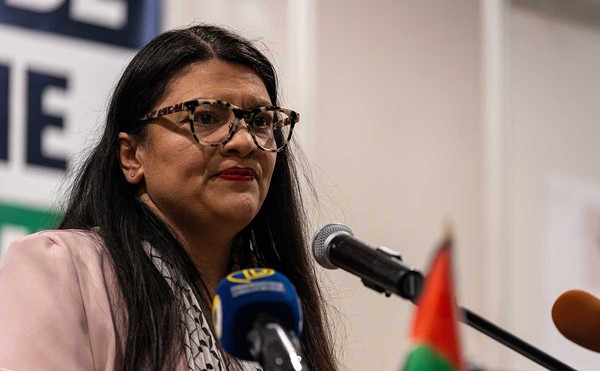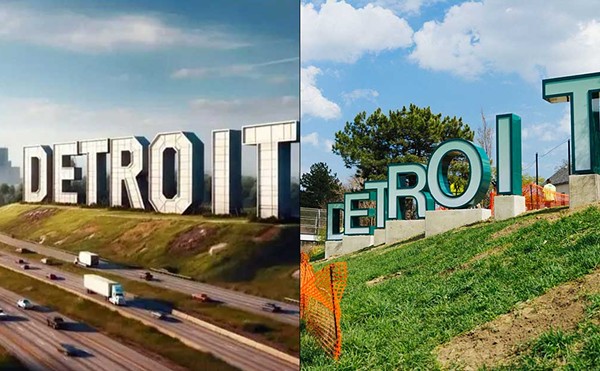We're thinking Carmine Palombo must be an optimist.
When we talked with the head of transportation planning for the Southeast Michigan Council of Governments (SEMCOG) last week, he wanted us to help spread the word about a series of public meetings regarding the Woodward Alternatives Analysis, described as a "key project in building the first piece of a regional transit system."
Specifically, Palombo and his pals at SEMCOG are considering transit options for the 27-mile Woodward Avenue corridor stretching from the Detroit River to Pontiac.
What the planners want to hear, among other things, is how people feel about the various options being considered to improve transit along the corridor. Would they prefer to see a light rail system installed? An increase in express bus service? Bus rapid transit?
The latter, if you are not familiar with the term, "is an innovative, high capacity, lower cost public transit solution that can significantly improve urban mobility," according to the National BRT Institute's website. "This permanent, integrated system uses buses or specialized vehicles on roadways or dedicated lanes to quickly and efficiently transport passengers to their destinations, while offering the flexibility to meet transit demand."
It seems as if we've been talking about this issue forever.
What's different now is that we might actually be on the verge of seeing a foundation laid that could make it happen.
The Michigan Senate recently approved a package of bills that would lead to the creation of a regional transit authority for southeast Michigan.
"We are finally moving forward as a region and a state by taking this step toward creation of an RTA," Sen. Bert Johnson (D-Detroit) said in a statement issued after the vote. "After decades of stalled attempts, characterized by bitter partisanship and territorial disputes, I am pleased to say we are closer than ever to achieving the goal of building a functional mass transit system, competing for federal transit dollars and bringing southeastern Michigan into the 21st century."
As Johnson went on to point out, "Southeastern Michigan is alone among the 41 largest metropolitan regions in the nation in lacking a comprehensive regional transit system. Federal transit funds are unavailable to areas without an RTA and, as a result, Michigan has been known for years as a 'donor state' in Washington, D.C."
Even though it is heartily endorsed by Gov. Rick Snyder, passage of the legislation in the Republican-controlled House before the current lame-duck session expires isn't exactly a slam dunk, but Palombo and others are hopeful sanity will prevail.
Like we said, though, with this House, that's no guarantee.
The thing is, no matter what form of transit improvement anyone would like to see on Woodward, the likelihood of anything of significance actually happening along the entire route is virtually nil without the RTA.
That's because the RTA — which, as proposed, would cover Wayne, Macomb, Oakland and Washtenaw counties — would play a key role in helping fund projects.
As The Detroit News reported, "The legislation also would permit the transit authority to seek voter approval for a vehicle registration fee or millage to fund a modern public transportation system that could include light rail and rapid transit buses."
That ability to generate funding is crucial.
"Without an RTA to find additional revenue to potentially implement it, what we'd have is a nice study," Palombo told us.
"If we are going to have a transit system of any substance at all, it is totally dependent on getting an RTA that puts a face on public transit, that tells people who is in charge, and that goes out and asks people for dollars" to fund it.
The Woodward corridor, explained Palombo, is a key piece in the larger transit puzzle.
Like the entire system, the streetcar line now being proposed for a short stretch of Woodward from downtown to the New Center area is dependent on creation of an RTA. U.S. Secretary of Transportation Ray LaHood has said federal funding that would help pay for construction of that proposed line is dependent on creation of a regional authority.
The hope is to have an integrated system with all the various pieces working in concert. Making that happen is crucial to the future of this region.
Even so, with the fate of the legislation unknown (at least it was when this rag went to press Monday evening), Palombo and company were pressing ahead with a series of public meetings scheduled to begin this week and concluding Saturday, Dec. 15. (To learn exactly when and where specific meetings are being held, steer your Web browser toward semcog.org.)
Palombo said there's good reason for the optimism inherent in holding these meetings:
"I really think the legislation that's been proposed puts us in the best position we've ever been in to make public transit a success in this region."
Can do-gooders
Here's an event even the confirmed Grinches here at the Hits are happy to help promote: The MT's annual Filmanthropy event on Thursday, Dec 6. Bring three canned goods to the Birmingham Palladium 12 theater (located at 250 N. Old Woodward Ave.) between the hours of 6 and 9:30 p.m. and you get to see a film of your choice for absolutely free (excluding 3-D films). Given the cost of going to the movies these days, it's a good deal. More importantly, it helps our friends at Gleaners Food Bank fill bellies that might otherwise go empty.
News Hits is written by Curt Guyette. Contact the column at 313-202-8004 or [email protected].






